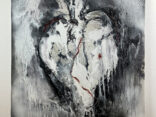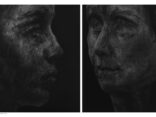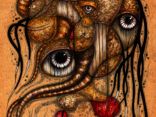Autore
Indice
- Intro
- Memory, Identity, Authenticity
- “Editing” Memories in the Brain
- The Strangers’ Quest
- A “Matrix”?
- Freud and Frankenstein
- The Strangers and Nosferatu
- The Beach and the Labyrinth
S&F_n. 13_2015
Abstract
This paper will address the question of aesthetic road design in relation with the psychology of the perception, in the United States during the second half of the twentieth century. Taking the work of the artist and theoretician Gyorgy Kepes (1906-2001) as a starting point, I propose to discuss the evolution of urbanism, from a gestalt informed perspective to a cybernetic one, which anticipated the emergence of the concept of smart city.
Alla cara memoria di Clara Cardia;
elle voulait amener la lumière dans les cités obscures
- Intro
Episodic memory – the recollection of past autobiographical events in which we feel involved or see ourselves as actors – is crucial for our sense of personal identity, of being the same as someone in the past. What would happen if the events we remembered as “ours” hadn’t really happened to us, but were fabricated or had been actually lived by someone else? Presumably nothing if we didn’t know about the deceit or if having “false memories” had no consequences for others. But what if we knew? Dark City, Alex Proyas’ film of 1998, tells the story of a man who did.
- Memory, Identity, Authenticity
In Western culture since the late 17th century, personhood has been defined primarily by self-consciousness, as well as by one’s capacity to remember directly or indirectly experienced past events and actions, and to identify oneself as oneself[1]. The first systematic elaboration of such view occurs in the chapter entitled “Of identity and diversity” of the second edition of British philosopher John Locke’s Essay on Human Understanding (1694). Locke proposed to base personal identity on the continuity of memory and consciousness, regardless of the material substance to which they may be attached. To such an extent did he make personal identity depend on self-consciousness, that, for him, if consciousness were located in the little finger and this finger cut of the hand, «it is evident the little finger would be the person, the same person; and self then would have nothing to do with the rest of the body»[2]. In short, a person’s identity reaches «as far as this consciousness can be extended backwards to any past action or thought»[3]. Hence, too, the radical consequence of amnesia:
[…] Suppose I wholly lose the memory of some parts of my life, beyond a possibility of retrieving them, so that perhaps I shall never be conscious of them again; yet am I not the same person that did those actions, had those thoughts that I once was conscious of, though I have now forgot them? To which I answer, that we must here take notice what the word I is applied to; which, in this case, is the man only. And the same man being presumed to be the same person, I is easily here supposed to stand also for the same person. But if it be possible for the same man to have distinct incommunicable consciousness at different times, it is past doubt the same man would at different times make different persons […][4].A gap in the continuousness of memory defines two different persons, though attached to the same physical organism. Such psychologization of personhood and personal identity was accompanied by their cerebralization. As seat of memory and consciousness, the brain became the one organ we need in order to be ourselves as persons; and insofar as the brain assumed such ontological function, human beings could be seen as “cerebral subjects”[5]. We shall later see how Dark City enacts them both.
Some of the debates around Locke’s theory of personal identity were prompted by the fact that memory is notoriously malleable and unreliable. This has also been the subject of considerable scientific research. As time passes from the moment we live a particular event, we spontaneously tend to accept more false details as true[6]. Moreover, memory is highly manipulable. Starting in the 1970s, psychologist Elizabeth Loftus demonstrated how easily it is distorted when subjects are exposed to misinformation. In 1995, she went beyond, and implanted in human subjects the entirely false memory that at the age of five they had been lost in a mall and were rescued by an elderly stranger[7]. This result raises questions about the place of memories, and of authentic vs. spurious recollections, in bringing about personal identity and a sense of self. Indeed, if memory plays a constitutive existential and ontological role, would we remain ourselves with alien memories? Beyond what degree of memory loss and replacement are we deprived of our “true self”? And is there such a thing? We reach here the memorial thresholds of personal identity and the experiential limits of authenticity. Indeed, on the one hand,
being oneself is inescapable, since whenever one makes a choice or acts, it is oneself who is doing these things. But on the other hand, we are sometimes inclined to say that some of the thoughts, decisions and actions that we undertake are not really one’s own and are therefore not genuinely expressive of who one is[8].
Authenticity can be conceptualized along three dimensions: self-alienation, or the gap between conscious awareness, and processes and contents, such as physiological states, emotions and beliefs, of which we are not aware; authentic living or being “true to oneself”; and the extent to which one accepts to conform to other people’s views and expectations[9]. There are other ways of thinking about authenticity, but this one has the advantage of focusing on reflexivity and self-perception. It thus underlines the link between authenticity and memory: for one’s identity to be authentic, must one’s memories be “true” in that their contents correspond to lived events, or is it enough that they be felt or considered as one’s own, regardless of their source and empirical referent?
That is the question posed by Dark City, and the answer it suggests is that, from the experiential point of view, the contrast between “real” and “imaginary” may not be so important after all. A memorative experience (recalling something and feeling that it “really happened”) is in itself something that really happens. However, the decisive factor for one’s sense of personal identity, of being the same person as someone in the past, is not the content of the memory, but the feeling that what I remember belongs to me. This is highlighted by the case of a rare memory impairment in which the patient felt no personal ownership with regard to his autobiographical memories[10]. His recollections were accurate, but were not accompanied by a sense of “mineness” and lacked the feel of real happenings in his life. In both real life and science fiction, the inverse situation is more common. As shown by Loftus’ experiment of 1995, we are capable of feeling personal ownership of false memories – though, as rehearsed in many movies and illustrated in the “memory wars” of the 1990s, it is precisely their or other persons’ intuition that something is wrong with their recollections that, in film as in the courts of justice, gets the action going[11]. Both cases suggest the extent to which the sense of personal identity may be «a byproduct of the episodic memory system»[12]. A system whose fragility and malleability the neurosciences demonstrate at the chemical level.
- “Editing” Memories in the Brain
Around the year 2000, neuroscientists revived the notion that memories are not stored like static contents, but undergo a process of “reconsolidation” after they are retrieved, and must in fact be reconsolidated in order to persist. Reconsolidation takes place by way of protein synthesis in the amygdala, a subcortical structure located deep and medially in the temporal lobes. The amygdala is involved in processing emotional reactions such as fear, anger and pleasure; unpleasant experiences are translated into signals that trigger fear memories by changing neural connections there[13]. As could be expected from everything the neurosciences show, other brain structures are involved. In particular, the hippocampus is responsible for assembling a contextual representation of the environment in which fear is conditioned, and for transmitting it to the amygdala[14].
Why “conditioned”? Because that is the most commonly used experimental paradigm for studying memory. The predominant approach is that of “classical” or “respondent” conditioning, also known as “Pavlovian” after the Russian physiologist Ivan Pavlov (1849-1936). An innate, “unconditioned response” to an “unconditioned stimulus” (in Pavlov’s classic experiments, a dog salivating to the presentation of food) becomes the “conditioned response” to an initially neutral “conditioned stimulus” (e.g. a sound). The dog involuntarily “learns” to salivate to the sound. Another paradigm is that of “operant” or “instrumental” conditioning, in which a behavior is followed by various forms of “reinforcement” or “punishment,” thus leading to an increase or decrease in its frequency.
Psychologists and neuroscientists use variations of these paradigms, especially the classical, and operationalize memory formation as the involuntary learning of a behavior by means of conditioning. Research on reconsolidation tends to focus on fear or “aversive” memory. Rats in a maze – the most common animal model – are first conditioned to fear particular objects or locations. If the production of a certain protein is inhibited immediately after the animal is exposed again to the conditioned stimulus, the next presentation of the same stimulus will not elicit the conditioned fear response. In other words, the memory will have disappeared[15]. Other work with the same paradigm has shown that such plasticity also acts in the opposite direction: memories can be strengthened by the activation of certain proteins during reconsolidation[16].
These results have led scientists to anticipate the «therapeutic use of agents that disrupt reconsolidation to reduce the fear-arousing aspects of emotional memory in post-traumatic stress disorder (PTSD)»[17]. Discussion on the prevention and treatment of PTSD thus takes place largely in conjunction with research on the nature, mechanisms and management of reconsolidation. For example, administering a beta-blocker like propranolol after a traumatic event has been shown to reduce the appearance of PTSD symptoms, an outcome judged analogous to the ability of the drug to reduce retention of a conditioned fear response in experimental animals[18]. Given within hours of a traumatic episode, propranolol, commonly used for cardiac arrhythmias and hypertension, could block the emotional arousal accompanying the consolidation of the trauma’s memory. It is therefore hoped that beta-blockers will be effective not only prophylactically, but also in people diagnosed with PTSD[19].
The medical potential of neurochemical memory research has given rise to passionate debate. Observing that «[t]he capacity to alter or numb our remembrance of things past cuts to the heart of what it means to remember in a human way», the United States President’s Council on Bioethics raised in 2003 objections against “memory-blunting,” and stressed the connection between memory and moral responsibility[20]. In addition to identifying issues about the nature of personal identity and a potential for pharmacological abuse, it anticipated troubling legal and psychological consequences. Several bioethicists and legal scholars rejected the Council’s dystopian worries[21], and laboratory work with animals suggested that reconsolidation could be disrupted to reduce the «fear-arousing aspects of emotional memory» in PTSD without altering personality through changes in the associative structure of memory[22]. Moreover, as New York University neuroscientist Joseph LeDoux has observed, «every special date and anniversary, every advertisement, every therapy session, every day in school is an effort to create or modify memory. Tampering with memory is a part of daily life. If we take a more realistic view of just how much we mess with memory, the dampening of memories that produce emotional responses in traumatized individuals might seem less malevolent»[23].
The discussion has taken new directions since the discovery, in 2007, that inhibiting a certain enzyme in the rat’s cortex results in the erasure of long-term associative memories. In contrast to earlier studies, this suggests that no reactivation is needed to render the memory trace susceptible to the inhibitor. Thus, the persistence of a memory turns out to depend on the ongoing activity of the enzyme long after the memory is regarded as consolidated into a long-term stable form[24]. Reflecting on potential therapeutic applications, Yadin Dudai, one of the authors of the discovery, remarked that «what the field attempts to do at the end of the day is to erase not necessarily a single complete chunk of memory but to be able to blunt or erase the extremely annoying emotional burden of the traumatic experience»[25]. Treatments would therefore aim only to “dull” or “dampen” memories, not to wipe them out. Scientific results keep making the issue ever more complex. A study published in March 2011 showed that increasing the enzyme has the opposite effect, namely it enhances the memory and even restores fading ones[26]. As I write these lines research is pouring – mostly on rats[27], but also on human subjects, such as adolescents suffering from anxiety and stress-related disorders[28], some documenting the failure of pharmacological agents to block reconsolidation of traumatic memories in PTSD[29], or exploring whether memory traces of pain (and not only of fear) can be erased under clinical conditions[30].
The neuropsychological consensus is that recalling a memory makes it susceptible to modification, that the reconsolidation process can be manipulated or even inhibited[31], that remembering actually causes forgetting[32], and that therapeutic applications should aim at disentangling memories from associated painful emotions rather than at erasing them. In short, the chief goal of manipulating reconsolidation is less to delete memories than to «edit» them so as to «write out the pain»[33]. You keep the sentence, but no longer highlight it in red. However, given how inextricably intertwined form and content, style and meaning, color and composition are in human autobiographical memory, “rewriting” a memory may amount to creating a new one – apparently with the same “information”, but with the emotion gone.
Science fiction may have simplified in that it does not separate autobiographical memory from the normally present sense of ownership (as in the medical case mentioned above), nor isolate the contents of episodic memory from the emotions with which they are infused (as in the treatment of PTSD). But taking the individual memorative experience as a totality rather than enacting its components separately has allowed it to tell powerful stories.
- The Strangers’ Quest
In Dark City, a race of Strangers experiments on human beings to find out what makes them human. For that purpose, the Strangers create a city permanently immersed in darkness. Once a day, at 12 (noon or midnight, impossible to tell) they put everyone to sleep, and use their psychokinetic “tuning” faculty of altering physical reality to metamorphose the urban space. This, in a visually spectacular manner, turns the city itself into a full-fledged protagonist (Fig. 1). While the Strangers rearrange the city, its inhabitants are “imprinted” with new memories. They regain consciousness as different persons, but ignore that their autobiographical recollections, which they feel as their own, have been implanted.
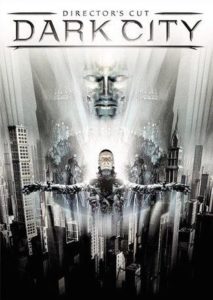 Figure 1: The Dark City morphs to the Strangers’ “tuning”
Figure 1: The Dark City morphs to the Strangers’ “tuning”
The Strangers do this in order to survive. They look human, but are in fact gelatinous, jellyfish-like extraterrestrial parasites that use male corpses as their hosts. Moreover, they share one “group mind” and are telepathically connected to each other. They are on the verge of extinction and think that, as a race, they may live on by becoming akin to human beings. But first they must understand what makes these beings human. They intuit some fundamental connection to memory in general, and in particular to the individual autobiographical memories they themselves lack. That inspires their experiments.
The Strangers’ premise, which drives them as well as the film, is clear enough: human selfhood resides in mental contents, and above all in individual episodic memories. Dark City is one of the many movies that take memory as «a shorthand for identity» and convey the idea that without memory «we cease to exist as who we are and become only receptors of current data»[34]. It may be comforting, against such Lockean view, to realize that, for people with dementia, how they «feel and what moves them becomes vastly more important than what they can remember», that as minds fade «bodies become ever more important as a source of identity», and that as memory-based identity disintegrates, relationships and emotions take center stage and encourage us to «avoid the temptation of becoming memory snobs»[35]. We nonetheless recognize that a massive loss of memories of our past life radically alters our being. That is why films depict retrograde amnesia, which involves loss of the memories formed before the amnesiogenic trauma, more frequently than the anterograde variety, in which the patient loses the capacity to create new memories after the trauma. Most memory movies exploit the dramaturgic potential of retrograde amnesia, which launches the (generally male) hero on a quest to recover the memories of his past, and thus to regain his original self[36]. Christopher Nolan’s celebrated Memento (2000) is an exception.
Other productions, including Dark City, explore the manipulation and fabrication of memories. The Strangers’ experiment is not so much about how memories are made or how they can be lost and regained, as about whether or not they must correspond to personally lived experiences. The movie thus raises questions about the connection between authenticity and personhood, and problematizes the link, which as spectators we tend to admit, between memory and the making and continuity of personal identity. The association of authenticity and memory in the making of the self feels natural. Yet, beyond its neurobiological correlates, it has proved to be a historical construct over which intense battles have been fought[37]. These battles, as Dark City illustrates, are essentially over the nature and control of the self. Through the adventures it narrates, the film asks whether we are the memories of what we have experienced, or rather the memories we experience. Would we remain ourselves with someone else’s recollections? Could we be “authentic” even if constituted by “false” memories? What would make those memories “false” given that they correspond to a real subjective event? What is their localization in the body and their role in human personal identity? And what are the individual and collective, psychological and political consequences of different answers to these various questions?
- A “Matrix”?
To my knowledge, two studies come close to dealing with this topic. One is J. P. Telotte’s Lost Memory and New Noir. Telotte, a scholar of film noir and science fiction cinema, explores the difference between the amnesiacs of classical film noir, who typically regain their identity through remembrance, and the situation of neo-noir protagonists, for whom there is «no possible recovery of memory, no reclamation of an original identity, not even a return to our originating point»[38]. Films such as Blade Runner or Dark City suggest that all individuals are “amnesiacs” insofar as they can construct the self and the world with memories that may be authentic or false, that may best lost and replaced.
The second study, Charles Tryon’s Virtual Cities and Stolen Memories: Temporality and the Digital in Dark City, examines the movie «as symptomatic of certain cultural anxieties regarding the digital mode of image production»[39]. Tryon’s argument that embodiment in Dark City represents only a small and inessential component of identity downplays the fact that memory is shown as localized in a bodily organ, the brain. The Strangers may be «searching for an authentic self beyond the layer of embodiment»[40], but they do so by manipulating a cerebral substance. That is why Dark City is less about disembodiment than about embrained memories and public personae as forms of embodiment.
Dark City, which was not commercially successful, has a blockbuster counterpart in The Matrix (Larry and Andy Wachowski, 1999). The Wachowski brothers’ “philosophical machine”[41], released a year after Proyas’, also is about a hero who discovers that he lives in a false reality and turns the manipulators’ powers against them to liberate humanity from their oppression. Some critics think the Wachowskis guilty of plagiarism or of unacknowledged heavy borrowing at the least[42]. The evidence is compelling, though it neglects cinematic patterns and motifs to which both films might be independently referring. In any case, the explicit role of the brain is different in each movie, and that makes a significant difference for the topic of embodiment.
The Matrix enacts the Cartesian fiction of persons being deluded by an evil genius that makes them believe they have a body and sensations, when in fact they are only an immaterial soul. Descartes’ fiction (in his 1641 Meditations on First Philosophy) has been updated as the “brain in a vat” thought-experiment. In both cases, experienced reality turns out to be a simulation; philosopher David Chalmers has called this solipsistic situation «the Matrix hypothesis»[43]. In Dark City, in contrast, people physically are in the environment they perceive, even if their identities are changed daily and if the place they inhabit is a spatial station constructed by the Strangers as a laboratory (Fig. 2).
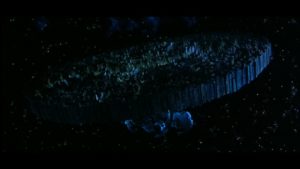 Figure 2: The Dark City seen from space
Figure 2: The Dark City seen from space
- Freud and Frankenstein
“Imprinting” is the main part of the Strangers’ experiment. Forced by his masters, Dr. Daniel P. Schreber (Kiefer Sutherland) extracts memories with a needle through sleeping people’s forehead, then manipulates them and injects them back. Daniel P. Schreber is the name of the German judge whose Memoirs of My Nervous Illness (1903) inspired Sigmund Freud’s Psychoanalytic Notes on an Autobiographical Account of a Case of Paranoia (1911). It has been argued that Dark City represents the judge’s pathological experience through the metaphor of the city[44]. The interpretation is far-fetched, but at a more obvious level, the movie does have a general Freudian flavor, as when Schreber synthesizes artificial memories by blending the painful reminiscence of a great love, an unhappy childhood, a bit of youthful rebellion, and a death in the family. A similar process of assemblage applies to the built environment itself: as one of the Strangers explains, «We fashioned this city on stolen memories, different eras, different pasts, all rolled into one».
The Freudian reference is all too evident, but the Strangers’ manipulations of urban matter and organic substance point to a deeper source. In Frankenstein; or, The Modern Prometheus (1818), Mary Shelley did not describe how Dr. Victor Frankenstein actually worked. Victor says that he «dabbled among the unhallowed damps of the grave», that he «collected bones from charnel houses», and that the «dissecting room and the slaughter-house furnished many of [his] materials». Yet the original novel includes no nightly forays into cemeteries or morgues, no organ removal from corpses, no stitching together of parts, and no visible sutures on the creature’s skin[45]. All these elements, which have become integral to the doctor’s creation, derive from James Whale’s Frankenstein of 1931. Whale’s “monster”, Boris Karloff’s first major role, is made up of alien parts – just like the Dark City itself, and just like the counterfeit memories and personalities of its imprinted dwellers. Proyas’ homage to Whale makes profound sense in several respects: the creature, the City and the memories are all “monstrous” in their experimental unnaturalness; but they are also monstra insofar as (following the Ciceronian and Varronian etymologies respectively) they reveal dramatic truths about human nature, and warn about the consequences of scientific hubris or existential despair; finally, it is only fitting that a film as indebted to the German Expressionist aesthetic as Dark City, which its multiple allusions to Nosferatu, Metropolis and The Cabinet of Doctor Caligari, also pay tribute to a film that emulated the look of those prestigious giants and became itself a classic.
- The Strangers and Nosferatu
The original Frankenstein avoids anatomic details, but Dark City does show how artificial memories are made. Schreber extracts memories through people’s forehead with a needle and the Strangers classify the memorative raw materials on an assembly line (Fig. 3). Schreber then prepares a liquid that somehow contains them, mixes them in test tubes, and controls under a microscope the process, visually evocative of cell fusion, whereby the ingredients form the compound that will be injected in the sleeping humans (Fig. 4).
Figure 3: Schreber’s memory needle and the assembly line of memories

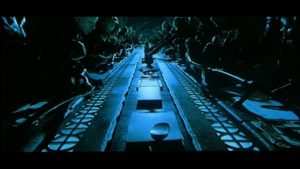
Figure 4: Memories “fuse” and form a liquid compound
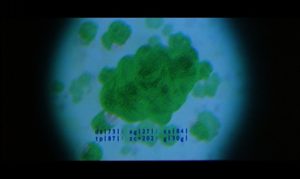
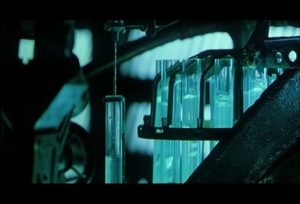
Such manipulations enact the psychologization and cerebralization of human personhood and personal identity. They also indicate that, since the Strangers can survive only by becoming essentially like humans (rather than just occupying human bodies), their relation to human memories will have to cease being merely experimental, and become predatory. This puts them on a par with their model: the expressionist vampire of Friedrich Wilhelm Murnau’s 1922 Nosferatu: A Symphony of Horror. Like Nosferatu, the Strangers are sinister and pale, have pointed ears and elongated hands, wear long dark clothes, and fear the sun, to which the vampire is mortally vulnerable (Fig. 5).
Figure 5: Nosferatu and the Strangers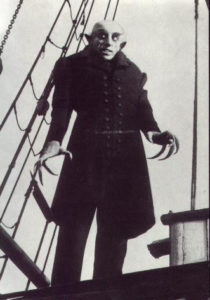
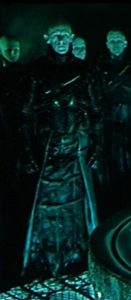
In Dark City and the character of the Stranger, the vampiric motif mingles with various resources and conventions of science fiction, gothic, cyberpunk and film noir (resulting in the hybrid know as future noir)[46], as well as with the themes of utopia and uchronia, of a place and a time that do not exist. But what really turns the Strangers into vampires is that human memories are to them what human blood is to Nosferatu. Memories, as we saw, are building blocks and basic components of personhood and personal identity; for the Strangers, they are truly their lifeline. Yet the Strangers are not content with consuming; they must also understand, and that is why they carry out experiments. The Dark City is their laboratory and Dr. Schreber, their head scientist.
- The Beach and the Labyrinth
Dark City begins with John Murdoch (Rufus Sewell) waking up in the bathtub of a hotel room, not knowing who he is or what is happening. In the room he finds a suitcase whose contents may furnish some clues, and that prompts him to begin looking for his identity. That starts off the plot. Up to this point, the script and basic ideas resemble those of many other movies that explore memory. But Murdoch is different. He is the only human to share with the Strangers the “tuning” faculty and to know that his memories are implanted. He thereby becomes a threat to the Strangers, who, in an attempt to track him down, inject their fellow Mr. Hand with memories originally intended for Murdoch. This element of the plot generates a lot of the film’s action. What interests us here, however, is that Murdoch initially tries to piece together his past, but in the end, contrary to most heroes of filmic psycho-scientific fiction, gives up the search and creates a reality that matches his “imprinted” self. Does Murdoch’s choice free him from the Strangers’ closed experimental space? What kind of consistency does he have once he transforms the Dark City so that it corresponds to the alien memories he has assumed as his own? And what is the ontological texture of the world he will henceforth inhabits? Answers to these questions are embodied in two antithetical places, the beach and the labyrinth.
The Beach
Among the things Murdoch finds in the suitcase during the opening sequence of Dark City are a postcard of a seaside town called Shell Beach and a notebook with a child’s drawings, labeled “Guide to Shell Beach by Johnny Murdoch” (Fig. 6).
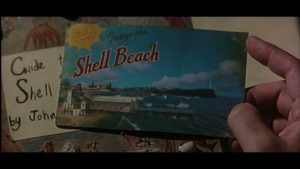
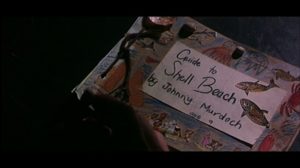
Figure 6: Postcard of Shell Beach and Johnny Murdoch’s “Guide to Shell Beach”
Several times throughout the film, Murdoch experiences “flashbulb memories” of Shell Beach. (The term flashbulb memories was coined to convey the vividness with which highly emotional memories are recalled[47]). In Dark City, such memories are depicted by means of extremely short shots to which a video filter has been applied. The sides of the frame are blurred towards a center, distorting camera perspective and producing a travelling-through effect or giving the impression of a “black hole” into which the displayed “memories” are sucked. Moreover, the entire image is blurred so as to suggest temporal distance (Fig. 7).

Figure 7: Flashbulb memory of Shell Beach
John Murdoch’s recollections contrast with how memories are represented in other films that explore the experienced past, such as those of Alain Resnais or Andrey Tarkovsky, which favor slow and protracted sequences. The extreme speed of memories in Dark City makes them slippery and may signal their lack of ontological consistency. Yet a flashbulb memory of Shell Beach convinces Murdoch that his recollections are false and that, in truth, he does not know who he is. As far as the remembering subject’s life is concerned, such memories have no referent outside themselves; their foundation is as fleeting as the fast speed montage that produces them, and they give rise to a feeling of self-alienation that becomes a driving force in the remembering person’s life.
The central role of Shell Beach as utopia and uchronia – a place that does not physically exist and happens in the sort of timelessness that Freud attributed to the Unconscious – is further affirmed in a fugitive homage to Citizen Kane (Fig. 8).
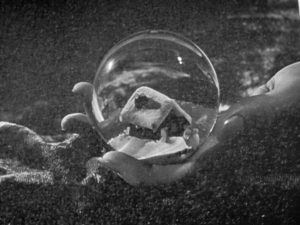
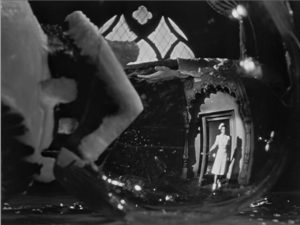
Figure 8: The snow globe of Citizen Kane (Orson Welles, 1941)
In Orson Welles’ film of 1941, the printed press magnate Charles Foster Kane dies murmuring “Rosebud” and letting go of a snow globe he held in his hand. The search for the meaning of that word motivates the story. In the end, it turns out to be the name of Kane’s childhood sledge. The snow-covered landscape in the globe symbolizes the paradise Kane lost when his mother entrusted him to the banker who managed his unexpectedly inherited large fortune. The second image in Fig. 7, reflecting the nurse who enters the dead Kane’s room, suggests the weight of his early trauma, and the extent to which the magnate may have never ceased to experience the world through the fragile glass of memory, now broken and doomed to definitive forgetting.
Although in Dark City nobody knows where Shell Beach is, everybody is familiar with it, and it is for all an orienting landmark. Like “Rosebud” and the snowy countryside, it is both a puzzling first origin and an unattainable final destination. Thus, during a taxi ride, Murdoch speaks of Shell Beach; like other questioned individuals, the driver claims to have been there and even has a Shell Beach snow globe as souvenir (Fig. 9); but when he tries to explain the way, he gets confused and doesn’t know how to go.
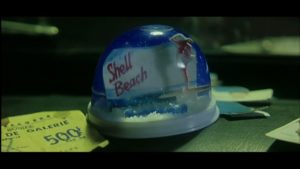
Figure 9: Souvenir of Shell Beach
Other situations highlight the extent to which individuals’ memories in the Dark City are “false”. The first time John Murdoch looks into Johnny Murdoch’s “Guide to Shell Beach,” the notebook is full of drawings; later on, in the home of his supposed uncle Karl (John Bluthal), the pages appear blank (Fig. 10).
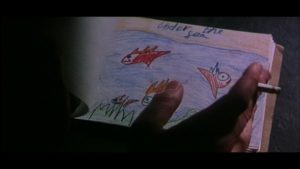
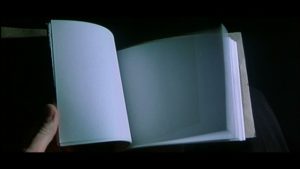
Figure 10: Johnny Murdoch’s “Guide to Shell Beach” – at the hotel and at Uncle Karl’s
Still later, Karl shows John a home movie where his nephew appears as a teenager. But John the adult lacks the scar that clearly shows on Johnny’s right arm, a trace of the fire that had killed his parents (Fig. 11).

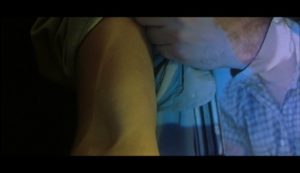
Figure 11: Johnny Murdoch’s scar and John Murdoch’s arm
Yet it is the water journey to Shell Beach that best symbolizes the role of forgetting and the forgotten in constituting personhood. Murdoch, Dr. Schreber and inspector Frank Bumstead (William Hurt), who had been pursuing Murdoch for murders he (Murdoch) does not remember, sail in a boat toward Shell Beach. The trip has distinct mythological and Dantean resonances. In Greek mythology, Charon carries the souls of the newly deceased across the rivers Styx and Acheron into the realm of the dead. In Inferno (canto 3), he refuses to transport Dante and Virgil; in Purgatorio (canto 31), Dante is dipped into Lethe, another river of Hades, from which individuals purified in Purgatory drink in order to forget their sins before entering Heaven. The river voyage in Dark City leads to a final destination that also requires forgetting: the false memory of Shell Beach. Indeed, the boat reaches a door, which seems to open onto a blue sky. This singular patch of color, however, belongs to a billboard advertising the resort. And beyond it, there is only the cosmic void that surrounds the complex experimental machine of the Dark City (Fig. 12).
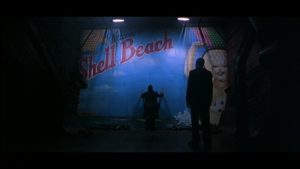
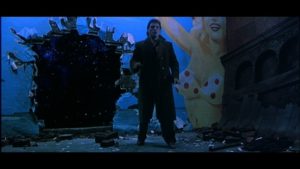
Figure 12: Shell Beach – a billboard and the empty space behind it
Nevertheless, as we shall see, this gloomy discovery is not the end of Shell Beach. That place, which is the only one in the film to be shown in daylight, encapsulates John Murdoch’s destiny. It is the goal of his pursuit, but at the same time the center of a maze in which he is confined as a laboratory rat. His life and his person are defined by the labyrinth from which there is little chance to escape, and by the beach, simulacrum of an open territory on which to roam and from which to sail toward the distant horizon.
The Labyrinth
As mentioned, the laboratory rat learning to navigate a maze is the favorite animal model for studying human memory. Schreber, a memory specialist, proceeds essentially like a mid-20th century psychologist or a more recent neuroscientist. Differently shaped experimental mazes have long been standard in research on learning and memory, some of it purely behavioral, other including brain lesions or neurochemical manipulations (Fig. 13).
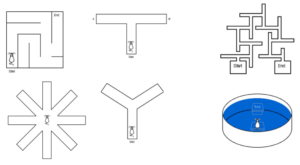
Figure 13: Experimental mazes for the rat
Although Schreber’s spiral-like labyrinth (Fig. 14) has a research function, its shape, particularly complex and different from that of ordinary animal psychology mazes, points to meanings that lie beyond the laboratory. From the individual city dweller to the urban space at large, and to the Strangers’ predicament itself, the labyrinth epitomizes the Dark City’s design and raison d’être, and the recurrent spirals are signs reminding everyone that they still inside it.
Figure 14: The experimental maze in Schreber’s laboratory
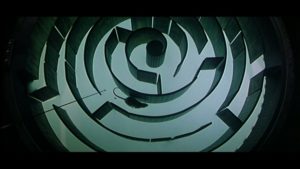
When fleeing the hotel in the film’s initial scene, Murdoch encounters the body of an assassinated prostitute, marked in the flesh with bloody spirals that recall Schreber’s maze (Fig. 15).
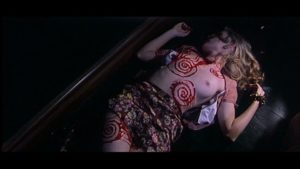

Figure 15: Assassinated prostitutes, marked with labyrinthine spirals
Detective Eddie Walenski (Colin Friels), who had to investigate the case, became pathologically obsessed with the same pattern (Fig. 16).
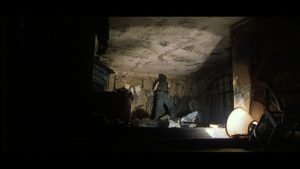
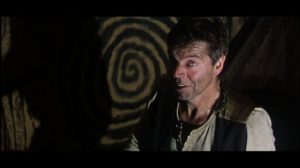
Figure 16: Mad detective Eddie Walenski, obsessed with spiral labyrinths
The clouds that hang over the Dark City form a giant spiral, and spirals appear on the title screen. Their resemblance to the balance springs of mechanical watches underlines the theme of time, its manipulation and its inescapable nature; and their analogy to fingerprints conjures the theme of individual identity (Fig. 17).
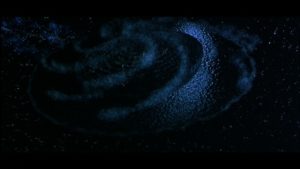
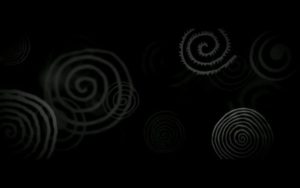
Figure 17: Cloud spirals hang over the Dark City, and spirals appear on Dark City’s title screen
Finally, the spiral-like laboratory maze provides the blueprint for the city at large. To the extent that the Strangers are running, as they say, an experiment on memory, the entire urban space is built like a labyrinthine maze, with humans in the role of the lab rat (Fig. 18).
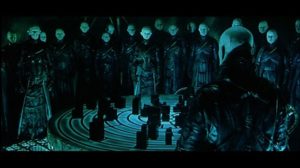
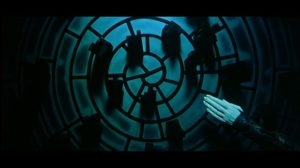
Figure 18: The Strangers prepare their “tuning” operations on the city plan
As a closed environment, the maze-city differs from the great mythological labyrinths where various cultures have imagined their heroes. The Western tradition has Theseus, who killed the Minotaur and managed to leave the Cretan labyrinth thanks to a ball of thread given to him by Minos’ daughter Ariadne. From the Strangers’ labyrinth, there is no physical escape. Yet there is an Ariadne in the Dark City: Emma Murdoch (Jennifer Connelly). After eliminating the Strangers, John uses his tuning power to materialize his memories of Shell Beach and refashion the somber cityscape as a sunny natural world. That is where Emma appears – or rather, a woman called Anna, who looks exactly like John’s wife, has no recollection of any John Murdoch whatsoever, but wishes, like John, to live happily ever after. Dark City thus proclaims that we can survive a radical memory manipulation, and become an authentic person with counterfeit memories. Only Murdoch knows the truth, but he is able to sustain the loss of his original identity because he can, apparently at least, break away from “self-alienation” and in engage in “authentic living”.
It seems like Murdoch’s «individual act of freeing himself from the ideological hold of the Strangers has the effect of freeing the entire society from their control as well»[48]. In an equally positive ecological key, Shell Beach and the sea have been interpreted «as symbols of the life sustaining power of water and, ultimately, of irrational nature, the only successful ecosystem presented in Dark City»[49]. Indeed, the noir city is typically dystopic[50], and its clash with the idyllic seaside reproduces traditional dichotomies: the city (always anomic and corrupt) vs. the farmland or countryside, and, ultimately, culture vs. nature. Only that in Dark City, obeying the latter’s moral authority amounts to materially landscaping a bleak world according to one’s luminous desire.
With Murdoch’s final “tuning,” the Dark City transmutes into a postmodern Città del sole, whose inhabitants will again be able to develop “true memories.” However, the identity Murdoch accepts, and which constitutes the foundation of his apparently emancipatory act, is largely based on memories that were forced on him, and for which no alternative is available. That suggests a more fatalistic lesson. For the fact is that the final sunrise, accompanied by Trevor Jones’ appropriately uplifting music, does not dissipate the spiraling clouds that hover above the former Dark City (Fig. 19).
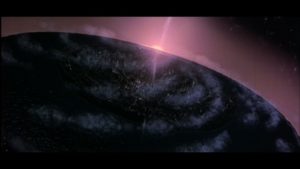
Figure 19: Sunrise over the former Dark City
Even if those clouds were nothing other than a gentle early morning brume, wouldn’t the newly freed humans still remain trapped in the labyrinth of their implanted memories? And if the end were happy and felt as authentic, would that be an issue? Presumably not if Ezra Pound was right when he wrote
nothing matters but the quality
of the affection –
in the end – that has carved the trace in the mind
dove sta memoria[51].
[1] U. Thiel, The Early Modern Subject: Self-Consciousness and Personal Identity from Descartes to Hume, Oxford University Press, New York 2011.
[2] J. Locke, Essay on Human Understanding (2nd ed., 1694), Book II, chap. 27, § 17.
[3] Ibid., § 9.
[4] Ibid., § 20.
[5] F. Vidal, Brainhood, anthropological figure of modernity, «History of the Human Sciences», 22, 2009, pp. 5-36; F. Vidal, The Sciences of the Soul: The Early Modern Origins of Psychology, University of Chicago Press, Chicago 2011.
[6] A. Mendelsohn et al., Subjective vs. Documented Reality: A Case Study of Long-Term Real-Life Autobiographical Memory, «Learning & Memory», 16, 2009, pp. 142-146.
[7] E. F. Loftus and J. E. Pickrell, The formation of false memories, «Psychiatric Annals», 25, 1995, pp. 720-725; E. F. Loftus, Creating false memories, «Scientific American», 227(3), 1997, pp. 70-75; Id., Our changeable memories: legal and practical implications, «Nature Reviews Neuroscience», 4, 2003, pp. 231-234.
[8] S. Varga and C. Guignon, “Authenticity”, Stanford Encyclopedia of Philosophy (Fall 2014), ed. E. N. Zalta,
http://plato.stanford.edu/archives/fall2014/entries/authenticity/.
[9] A. M. Wood et al., The Authentic Personality: A Theoretical and Empirical Conceptualization and the Development of the Authenticity Scale, «Journal of Counseling Psychology», 55(3), 2008, pp. 385-399.
[10] S. B. Klein and S. Nichols, Memory and the sense of personal identity, «Mind», 121(483), 2012, pp. 677-702.
[11] “Memory wars” designates a sometimes venomous controversy over the reliability of repressed memory and the validity of recovered memory therapy. See, most famously, F. Crews et al., The Memory Wars: Freud’s Legacy in Dispute, New York Review Books, New York, 1995; and most recently, L. Patihis et al., Are the “Memory Wars” Over? A Scientist-Practitioner Gap in Beliefs About Repressed Memory, «Psychological Science», 25(2), 2014, pp. 519-530.
[12] Ibid., p. 696.
[13] J. P. Johansen et al., Hebbian and neuromodulatory mechanisms interact to trigger associative memory formation, «PNAS», 111(51), 2014, E5584-E5592.
[14] C. A. Orsini and S. Maren, Neural and cellular mechanisms of fear and extinction memory formation, «Neuroscience and Biobehavioral Reviews», 36, 2012, pp. 1773–1802.
[15] J. Debiec, J. E. LeDoux and K. Nader, Cellular and Systems Reconsolidation in the Hippocampus, «Neuron», 36, 2002, pp. 527-538.
[16] N. C. Tronson et al., Bidirectional behavioral plasticity of memory reconsolidation depends on amygdalar protein kinase A, «Nature Neuroscience», 9, 2006, pp. 167-169.
[17] V. Doyère et al., Synapse-specific reconsolidation of distinct fear memories in the lateral amygdala, «Nature Neuroscience», 10, 2007, p. 415.
[18] R. K. Pitman et al., Pilot study of secondary prevention of posttraumatic stress disorder with propranolol, «Biological Psychiatry», 51, 2002, pp. 189-192; G. Vaiva et al., Immediate Treatment with Propranolol Decreases Posttraumatic Stress Disorder Two Months after Trauma, «Biological Psychiatry», 54, 2003, pp. 947-949.
[19] J. L. C. Lee and B. J. Everitt, Reactivation-Dependent Amnesia: Disrupting Memory Reconsolidation as a Novel Approach for the Treatment of Maladaptive Memory Disorders, in B. Bontempi, A. J. Silva and Y. Christen (ed. by), Memories: Molecules and Circuits, Springer, Berlin, 2007. Trauma is also a historical and cultural phenomenon, but PTSD literature never cites work such as A. Young’s The Harmony of Illusions: Inventing Post-traumatic Stress Disorder, Princeton University Press, Princeton, 1997, or When Traumatic Memory Was a Problem: On the Historical Antecedents of PTSD, in G. M. Rosen (ed. by) Posttraumatic Stress Disorder: Issues and Controversies, Wiley, Chichester, 2004, pp. 127-146.
[20] President’s Council on Bioethics, Beyond Therapy: Biotechnology and the Pursuit of Happiness, Dana Press, New York, 2003.
[21] For objections to the Council’s positions, see K. Evers, Perspectives on Memory Manipulation: Using Beta-Blockers to Cure Post-Traumatic Stress Disorder, «Cambridge Quarterly of Healthcare Ethics», 16, 2007, pp. 138-146; M. Henry, J. R. Fishman and S. J. Youngner, Propanolol and the Prevention of Post-Traumatic Stress Disorder: Is it Wrong to Erase the “Sting” of Bad Memories?, «American Journal of Bioethics», 7, 2007, pp. 12-20; the commentaries in the same issue of AJOB; and especially A. J. Kolber, Therapeutic Forgetting: The Legal and Ethical Implications of Memory Dampening, «Vanderbilt Law Review», 59, 2006, pp. 1561-1626.
[22] J. Debiec et al., Directly reactivated, but not indirectly reactivated, memories undergo reconsolidation in the amygdala, «Proceedings of the National Academy of Sciences», 103, 2006, pp. 3428-3433.
[23] J. E. LeDoux, Can Memories Be Erased? (2010), www.huffingtonpost.com/joseph-ledoux/can-memories-be-erased_b_303519.html.
[24] R. Shema, T. C. Sacktor and Y. Dudai, Rapid Erasure of Long-Term Memory Associations in the Cortex by an Inhibitor of PKMz, «Science», 317, 17 August 2007, pp. 951-953; R. Shema et al., Boundary conditions for the maintenance of memory by PKMz in neocortex, «Learning & Memory», 16, 2009, pp. 122-128.
[25] J. M. Abi-Rached, The Implications of Memory Research and “Memory Erasers”: A Conversation with Yadin Dudai, «BioSocieties», 4, 2009, p. 85.
[26] R. Shema et al., Enhancement of consolidated long-term memory by overexpression of protein kinase Mzeta in the neocortex, «Science», 331, 2011, pp. 1207-1210.
[27] E. Baldi and C. Bucherelli, “Brain sites involved in fear memory reconsolidation and extinction of rodents”, Neuroscience and Biobehavioral Reviews, 53, 2015, 160-190.
[28] D. C. Johnson and B. J. Casey, Extinction during memory reconsolidation blocks recovery of fear in adolescents, «Scientific Reports», 5, 8863, 2015, doi:10.1038/ srep08863.
[29] N. E. Wood et al., Pharmacological blockade of memory reconsolidation in posttraumatic stress disorder: Three negative psychophysiological studies, «Psychiatry Research», 225, 2015, pp. 31-39.
[30] J. Sandkühler and J. Lee, How to erase memory traces of pain and fear, «Trends in Neurosciences», 36(6), 2013, pp. 343-352.
[31] E. G. Meloni et al., Xenon impairs reconsolidation of fear memories in a rat model of post-traumatic stress disorder (PTSD), «PLoS ONE», 9(8), 2014, e106189.
[32] Or more precisely: «Remembering does not merely reawaken memories of the past, it […] induces forgetting of other experiences that interfere with retrieval, dynamically altering which aspects of our past remain accessible», M. Wimber et al., Retrieval induces adaptive forgetting of competing memories via cortical pattern suppression, «Nature Neuroscience», 18, 2015, p. 588.
[33] M. Specter, Partial recall. Can neuroscience help us rewrite our most traumatic memories?, «The New Yorker», 19 May 2014, www.newyorker.com/magazine/2014/05/19/partial-recall (an excellent introduction to this vast topic).
[34] J. Bowman, Memory and the Movies, «New Atlantis: A Journal of Technology and Society», 5, 2004, p. 85 and p. 88.
[35] C. Leadbeater, The disremembered, «Aeon», 26 March 2015, http://aeon.co/magazine/psychology/where-does-identity-go-once-memory-falters-in-dementia/.
[36] F. Vidal, Memory, Movies, and the Brain, in S. Nalbantian, P. M. Matthews and J. L. McClelland (ed. by), The Memory Process: Neuroscientific and Humanistic Perspectives, MIT Press, Cambridge, Mass., 2011, pp. 395-415.
[37] Alison Winter, Memory: Fragments of a Modern History, University of Chicago Press, Chicago, 2012.
[38] J. P. Telotte, Lost Memory and New Noir, «Paradoxa», 16, 2001, p. 185.
[39] C. Tryon, Charles, Virtual Cities and Stolen Memories: Temporality and the Digital in Dark City, «Film Criticism», 28, 2003, p. 49.
[40] Ibid., p. 48.
[41] A. Badiou et al., Matrix, machine philosophique, Ellipses, Paris, 2003.
[42] J. Morales, Comparación de los filmes Dark City & The Matrix (2002), www.quintadimension.com/article193.html. English version together with V. Jaubert’s comparison of the two films in Matrix City: A Photographic Comparison of “The Matrix” and “Dark City”, www.electrolund.com/2004/10/matrix-city-a-photographic-comparison-of-the-matrix-and-dark-city.
[43] D. Chalmers, The Matrix as Metaphysics (2003), http://consc.net/papers/matrix.html.
[44] D. H. Wilson, The Pathological Machine: Dark City’s Translation of Schreber’s Memoirs, «Journal of the Fantastic in the Arts», 15, 2005, pp. 153-164.
[45] J. Sutherland, How does Victor make his monsters?, in Is Heathcliff a Murderer? Great Puzzles in Nineteenth-Century Fiction, New York, Oxford University Press, 1998, pp. 24-34.
[46] J. M. Aziz, “Future Noir”, Summer Special: Postmodern and Future Noir (2005), www.crimeculture.com/Contents/Articles-Summer05/JemAziz1.html. To my knowledge, comments of Dark City do not mention the homonymous B-rate film noir of 1950, directed by William Dieterle and featuring Charlton Heston in his first professional cinema appearance. The two movies have nothing in common except that they take place mostly in dark or badly lit urban locations. But this is a common feature of the noir genre.
[47] R. Brown and J. Kulik, Flashbulb Memories, «Cognition», 5, 1977, pp. 73-99.
[48] T. McGowan, Fighting Our Fantasies: Dark City and the Politics of Psychoanalysis, in T. McGowan and S. Kunkle (ed. by), Lacan and Contemporary Film, Other Press, New York, 2004, 145-172, p. 148.
[49] R. L. Murray and J. K. Heumann, Ecology, Place, and Home in Dark City: Is It Our Nature to Live in the Dark?, in Ecology and Popular Film: Cinema on the Edge, State University of New York Press, Albany, 2009, p. 84.
[50] G. Prakash (ed. by), Noir Urbanisms: Dystopic Images of the Modern City, Princeton University Press, Princeton 2010.
[51] Ezra Pound, The Pisan Cantos, 76, 157-160.




